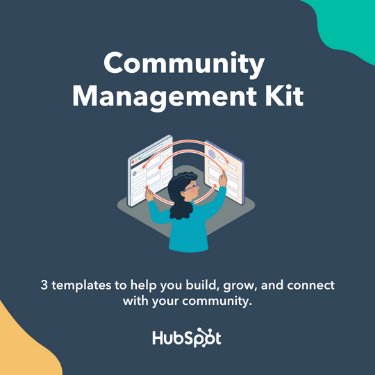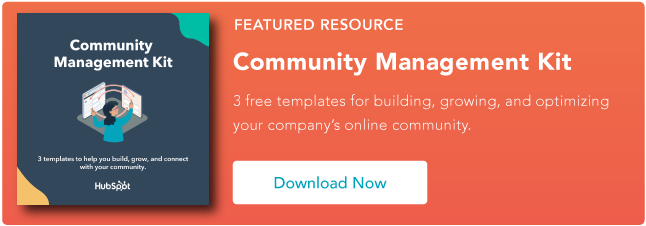But what exactly is a community manager, anyway? Here, we’re going to explore what a community manager is and — if you’re applying or starting out in the role — how to be a great one.
Table of Contents
- What is a Community Manager?
- How to Become a Community Manager
- Community Manager Job Description
- Community Manager Job Responsibilities
- How to Be a Great Community Manager
- Community Manager Job Outlook
- Community Manager Org Chart
If you ask Krystal Wu, HubSpot’s Social Media Community Manager (@hellokrystalwu), the most critical part of the community manager role, she’ll say it’s simply “having one.”
The community manager position builds brand personality and consumer trust, which can ultimately lead to increased awareness and company performance — making it a critical component of your marketing strategy.
How to Become a Community Manager
Community managers come from a variety of backgrounds — anything from recruiting to journalism to engineering — because being successful in the role relies more on a set of skills than a degree.
First, it’s important for community managers to be knowledgeable about and across the business. Community managers should be able to rely on their experience with their organization to confidently address their audience or tap into internal resources to appropriately handle any issues that may arise.
Beyond a working understanding of the business, managers need to build productive, professional relationships both internally and externally in order to be more authentic and reliable brand ambassadors.
Community Manager Job Description

What does it take to be a community manager? Here are some of the essential soft and hard skills you need:
- Background in a support-related field such as customer success.
- Strong soft skills such as communication both online and in-person.
- Solid understanding of the organization, including product knowledge.
- Ability to build and implement community-focused content strategies.
- An understanding of PR-related activities.
- Social media savvy to drive interest and engagement.
- Event management and promotion skills, both online and in person.
In order to advocate for and preserve an organization’s brand, community managers must have incredibly strong soft skills. Above all, empathy, good listening skills, and adaptability are crucial to promoting favorable impressions of an organization.
Beyond interpersonal skills, the best community managers are actively researching trends and hot topics — by engaging with the latest industry developments, community managers are better able to connect with relevant audiences and provide them with the most updated resources and best practices.
Krystal Wu emphasized adaptability as an important characteristic for success in the role — since the position is still developing and community managers are often carving out their own job descriptions, being flexible in order to adjust to new trends and expectations will serve you in the long run.
Ultimately, great community managers understand that theirs is a customer service-based role. Actively listen to customers, address concerns, demonstrate an authentic social presence, and maintain productive partnerships with consumers. In short, be a good human being for your audience on behalf of your brand.
What does a community manager do?

Build and maintain a community.
Community managers are responsible for building and maintaining a brand’s community — both online and offline — and public perception.
The job requires engaging audiences on a variety of outlets, including online forums, social media platforms, Slack, in-person groups, and more, to reach all audiences where they are.
Since different digital spaces have unique cultures and best practices, community managers must be the consistent tone and voice of the brand.
As Krystal Wu points out, “When I speak, I am on the line for HubSpot. I’m not Krystal, I’m HubSpot.”
As a community manager, all your messaging, content, and crisis management across networks should be prompt, consistent with your brand, and empathetic to create a loyal and delighted community.
Manage public relations.
PR is another basic tenet of managing and extending a brand’s audience as community managers are engaging with all kinds of press — both positive and negative — generated about their companies.
How managers navigate legal issues or negative press can separate good community managers from great ones.
Missteps in this role can do real damage to a brand, so connecting with your organization’s legal, PR, or related teams can help mitigate problems and make sure that responses are coming out appropriately.
Create strategies.
Additionally, great community managers are constantly thinking about how they might experiment with new strategies.
For instance, Krystal Wu has learned that a tactic or test won’t run the first time, but you shouldn’t be discouraged — progress takes time. Community managers should think about the long term — the more you invest in an improved strategy, new direction, or the position itself, the more you’ll get out of it.
An easily forgotten resource is an external network of other community managers! Finding others in similar positions can be very helpful in crowdsourcing informed solutions or leaning on experienced others who’ve handled similar situations in the past.
Cultivate brand presence.
Building on the usefulness of a PR skill set, community managers must be vigilant of their organization’s brand presence and assess the potential consequences of their corporate communications.
Brand presence includes consistency of voice across platforms to keep the company on track in terms of target audience awareness and engagement.
Consumers should be able to recognize brand voice across pillars — whether they’re seeing a post on Instagram or a question on Quora.

Track engagement.
Beyond direct interaction between the brand and its audience, community managers also record and report the engagement they see on at least a monthly basis.
Other teams that create content operate mostly on the backend, so it’s good to hear from the community manager who sees the response from consumers. They can help track whether followers are confused or what kinds of changes they are seeing within digital communities.
Krystal Wu says that she has developed an intuition about the psychology of HubSpot’s audience and can therefore evolve and tweak her outreach strategy in order to most effectively engage with target audiences.
Furthermore, community managers keep in mind their ideal audience, shaping content and communications to target the right audience rather than simply building a larger one.
Offer resilience.
When I asked Krystal if there were any challenges she faced that she hadn’t expected, she said she hadn’t anticipated the “emotional rollercoaster I deal with every day.”
The experience of engaging with a digital community can be volatile — one day might be full of positive and rewarding discussions, while the next might be hounded by complaints and disgruntled users.
It’s important that community managers maintain and control emotions in order to handle the various issues that arise.
Delight the community.

Lastly, great community managers delight their community.
Krystal Wu makes sure to give positive encouragement to her audience through gift cards, little presents, or what she calls “delight boxes,” which are filled with a bunch of fun HubSpot swag items.
Even when things go wrong, great community managers address problems, resolve them, and send gifts to those involved.
By building positive relationships with the members of your community — whether they have a positive impression of your brand or a negative one — you’re building a reputable and trustworthy brand perception.
How to Be a Great Community Manager
Like any job that requires frequent, and sometimes intense, communication with customers and community members, being a great community manager requires passion and dedication.
By understanding the skills you need and nurturing that skill set over time, you can become a great community manager who understands exactly how to manage your brand’s presence online.
Set yourself goals and objectives.
First, it’s important to set out some clear goals and objectives.
Regardless of how far along in a career you are, good community managers know how to combine the empathy and compassion needed for the job while remaining organized and objective.
Objectives for a community manager could relate to comment response times, brand sentiment levels, or engagement rates, among other things.
In combination with customer marketing, community management also contributes towards revenue goals.
As Laurie Aquilante Faiola, vice president of marketing and community-led growth at HubSpot, points out: “If you think about your customers or that initial purchase as the end of your marketing and sales funnel, you’re leaving a whole bunch of opportunity on the table.”
Having objectives helps to prioritize your workload and strategic initiatives, and provides the ability to demonstrate the value of your role when you achieve them.
Work on your listening skills.
Data is important, but the human element of community management cannot be underestimated. Rather than generating run-of-the-mill responses to comments, try listening carefully to what your community members are saying.
This applies to positive, neutral, and negative comments. Positive sentiment should be matched with the same energy.
Help your community members get excited about their contributions and actively engage with the thoughts or opinions they’re sharing.
Meanwhile, negative comments should be met with empathy and compassion, and your responses should show that you truly understand and care about solving challenges for your community.
Foster inclusivity.

There’s a lot that managers can do to ensure the community remains a safe and inclusive space for everyone.
All community members or contributors should be made aware that there are communication and behavior guidelines in place, including consequences for breaching these guidelines.
Whether it’s deleting comments or removing members from the space, it’s essential that these guidelines are enforced so that community members can feel safe and see that the brand is committed to their values.
Be quick off the mark.
Although community should be primarily driven by members rather than a brand, community managers should be a visible and frequent presence in discussions.
This includes timely responses to posts, comments, and reviews. With larger communities, it can be tricky to keep up. But, community managers should always strive for the fastest response times possible.
Provide value to foster discussions.
Content marketing is a huge aspect of community management. It gives you the opportunity to provide truly valuable resources to the community and can often be the spark that lights up a lively discussion.
“Consistent content creation is a cornerstone of community growth,” says Lucy Alexander, senior marketing manager at HubSpot. “To keep your community members returning regularly, they need to see new things each time they return."
From interesting articles and industry news to scheduling events or webinars, community managers who build content marketing into their strategy can increase engagement levels and improve brand sentiment.
Community Manager Job Outlook
Brands are increasingly recognizing the importance of effective community management, whether it’s across social media channels or dedicated platforms and support hubs.
Community managers bring a human touch to a brand’s online presence — one that is appreciated by both consumers and organizations alike.
In fact, 83% of consumers on Facebook prefer brand personality. And, according to Sprout Social, 21% of consumers are more likely to buy from brands that are accessible via social media.
From the organizational side, the support for community management roles is similarly robust. According to a report published by the Bureau of Labor Statistics, employment of social and community managers is expected to grow by 12% between 2021 and 2031.
While the rapid advancement of AI tools is likely to bring a level of increased automation to community management, anyone on this career track should rest easy.
As a role that requires a diverse skill set (including an emphasis on soft skills), it’s likely to be a role that evolves alongside AI rather than one that will be completely replaced.
Community Manager Salary
- Average entry-level community manager salary: $41,748
- Average early-career community manager salary: $48,673
- Average mid-level community manager salary: $51,428
- Average manager-level salary: $60,413
- Average late-career community manager salary: $72,000
Community Manager Org Chart
Community management can sit within and across different functions and teams.
It all depends on the unique internal set-up of an organization. In general, however, community management sits within a dedicated community function or within the social media team.
Here’s an example of where community management commonly sits in a social media org chart:

Beyond the org chart, the roles and responsibilities of a community manager can vary based on the team they sit in and their level of seniority within that team.
Associate-Level Community Manager
An associate-level community manager is an entry-level or junior position.
In this role, your responsibilities might include day-to-day tasks like responding to comments and requests, scheduling posts, and moderating community activity.
Team members with a junior-level customer service background can often move into this kind of role.
Mid-Level Community Manager
A mid-level community manager may take on all the tasks of an associate but with added responsibilities.
Common tasks at this level would also include creating or curating content, engaging in some strategy development, and analyzing and reporting on community metrics.
A mixture of hard and soft skills becomes more important at this level, as the manager will need copywriting, design, communication, and analytical skills.
Team Lead Community Manager
Next up in the org chart is typically the team lead level.
Overseeing mid-level and associate community managers, the community team lead is typically responsible for coordinating initiatives and strategies, setting and operationalizing community objectives, and guiding and supporting junior team members.
On top of other community-based skills, team members at this level also require leadership skills, project management knowledge, and strategic development capabilities.
Senior Management Level
At the senior management level within community management, responsibilities shift to a broader perspective.
Team members at this level need to understand organizational objectives and ensure the community strategy and tactics are fully aligned with these goals.
They’ll work closely on strategy development, budget management, and reporting on the team’s overall success and performance to the rest of the organization.
A robust knowledge of growth management, strategy, budget management, and stakeholder management is needed here.
Delight Your Community
Whether you’re just starting out in community management or looking to move up to the next level, take some time to analyze what you need to do to take your resume to the next level.
From hard skills like content creation and data analytics to crucial soft skills like communication, there is always something to learn in a role as diverse and exciting as community management.
And don’t forget to keep the end goal of your role in mind: to delight your community.
Community Management







![Experts Share Top Tips for Community Management [+ Examples]](https://53.fs1.hubspotusercontent-na1.net/hubfs/53/ft-community.webp)





